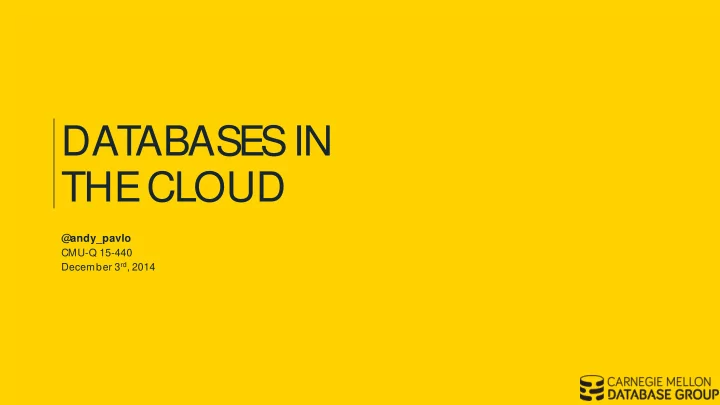

DAT ABASES IN THE CLOUD @andy_pavlo CMU-Q 15-440 December 3 rd , 2014
OLTP vs. OLAP databases . Source : https://www.flickr.com/photos/adesigna/3237575990
On-line Transaction Processing • Fast operations that ingest new data and then update state using ACID transactions. • Only access a small amount of data. • Volume : 1k to 1m txn/sec • Latency : >1-50 ms • Database Size : 100s GB to 10s TB 3
Example • -line game in the OLTP database. Pre-computed model Click OL TP DBMS Game Stream decides the next level Application the player is shown. Framework Game Updates 4
Example • -line game in the OLTP database. Click OL TP DBMS Game Stream Application Framework Real-time Game Monitoring Updates 5
Database Warehouses • Complete history of OLTP databases. • Complex queries that analyze large segments of fact tables and combine them with dimension tables. • Volume : A couple queries per second • Latency : 1-60 seconds • Database Size : 100s TB to 10s PB 6
Example • Compute model used to guide OLTP DBMS decisions from historical data. Click OL TP DBMS OLAP DBMS Game ETL Stream Application Framework Game New Updates Model 7
OLTP vs. OLAP • Storage Format: – OL TP → R ow-oriented – OLAP → Column-oriented • Primary Database Location: – OL TP → In-Memory – OLAP → Disks • Workloads: – OL TP → Write-Heavy – OLAP → R ead-Only 8
Things to consider with databases in the cloud . Source : https://www.flickr.com/photos/arvidnn/15285491335
Good Things • Better Resource Utilization • Elastic Scaling • Database-as-a-Service Offerings 10
Better Resource Utilization • Combine multiple silos onto overprovisioned resources. • Public platform providers achieve better economies of scale. • Database machines are (mostly) dead. • Optimal multi-tenant placement is a difficult problem. 11
Elastic Scaling • Automatically provision new resources on the fly as needed. • Scaling up vs. Scaling out . • Difficult for OLTP DBMS to continue processing transactions while data migrates. 12
OLTP Scale-out Example Elapsed Time TPC-C Benchmark on H-Store (Fall 2014) E-Store: Fine-Grained Elastic Partitioning for Distributed Transaction Processing R.Taft, E.Mansour, M.Serafini, J.Duggan, A.J. Elmore, A.Aboulnaga, A.Pavlo, M.Stonebraker 13 Scaling from 3 to 4 nodes Proceedings of the VLDB Endowment, vol. 8, iss. 3, pages. 245 256, November 2014.
Database-as-a-Service • Cloud provider manages physical configuration of a DBMS. • Ideal for applications that are co-located in • Combine private data with curated databases (i.e., data marts) 14
Bad Things • I/O Virtualization • File system Replication • Security + Privacy Concerns • Performance Variance 15
I/O Virtualization • Distributed file system stores data transparently across multiple nodes. • • This causes a DBMS pull data to query push query to data 16
OLAP I/O Virtualization SELECT YEAR( o_date ) AS o_year, AVG( o_amount ) FROM orders GROUP BY o_year ORDER BY o_year ASC Terabytes! Distributed Filesystem OLAP DBMS 17
OLAP I/O Virtualization SELECT YEAR( o_date ) AS o_year, AVG( o_amount ) FROM orders GROUP BY o_year ORDER BY o_year ASC Distributed Filesystem OLAP DBMS Bytes! 18
File System Replication • The DBMS should not rely on file system replication for durability. • OLTP systems maintain replicas in-memory. • OLAP systems can store copies of tables in different ways on replica nodes. 19
OLAP Replication Sort Order Replica #1 Table 1: name OLAP DBMS Table 2: name Sort Order Replica #2 Table 1: id Table 2: id 20
OLAP Replication Sort Order Replica #1 Table 1: name Table1.name ⨝ Table2.name OLAP DBMS Table 2: name Sort Order Replica #2 Table 1: id Table 2: id 21
Security + Privacy Concerns • No truly encrypted solution exists. • Many companies are unable to use public cloud platforms. 22
Performance Variance • DBMSs are sensitive to changes in underlying hardware performance. • large fluctuations in performance. 23
OLTP Performance Variance 35% Difference YCSB on MySQL (Winter 2012) OLTP-Bench: An Extensible Testbed for Benchmarking Relational Databases Djellel Eddine Difallah, Andrew Pavlo, Carlo Curino, Philippe Cudre-Mauroux 24 Medium EC2 Instances Proceedings of the VLDB Endowment, vol. 7, pages. 277 288, December 2013.
Cloud database vendors. Source : https://www.flickr.com/photos/alestra/8891585632
Important Features • Automatic Back-ups • Geo-replication • Elasticity / Live Reconfiguration • Efficient Multi-Tenancy • Workload Awareness 26
Cloud Database Vendors • Cloud-friendly systems • Database-as-a-Service (DBaaS) 27
Cloud-friendly DBMSs • Most DBMS vendors make it easy to deploy on cloud platforms. • Others provide support for easy scale-out in a cloud environment. • More than just pre-configured instances. 28
OLTP DBaaS • Amazon RDS / Aurora • Microsoft Azure • Google Cloud SQL • Database.com • ClearDB • GenieDB • Clustrix 29
OLAP DBaaS • Amazon Redshift • Google BigQuery • Microsoft Azure • Snowflake 30
Parting Thoughts • The cloud does not magically make database problems go away. • DBMS on the cloud. • AF AIK, there is no truly autonomous DBMS as of yet. 31
32
END @andy_pavlo
Recommend
More recommend